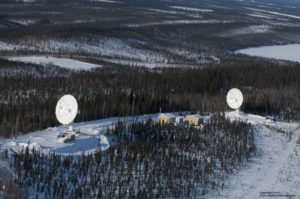
Swedish Space Corporation (SSC), in co-operation with Natural Resources Canada (NRCan), is expanding its data reception capabilities at the Inuvik Satellite Station Facility (ISSF) in Canada’s Northwest Territories. This expansion marks the next step in a long-standing and productive collaboration between SSC and NRCan.
As global Earth Observation activities continue to evolve, the growth of SSC capacity at the Inuvik Satellite Station Facility (ISSF) will enable many more customers to receive Earth observation data in support of their mission objectives.
SSC began operations at the ISSF in 2012. This spring, SSC will begin installing its new infrastructure that will expand its data reception and TT&C capabilities at the ISSF. It will also extend the “KINUVIK” solution of complete polar coverage provided by the coupling of SSC’s ground station in Kiruna, northern Sweden and the ISSF in Inuvik.
Over the years, SSC has built strong relationships in Canada and the Northwest Territories, which have helped to grow the ISSF, and allowed SSC to gain valuable experience working within the Canadian regulatory environment.
“SSC’s newest developments at the ISSF will further strengthen our capability to offer services which require high security and resiliency, as well as increase our adaptability to support new types of space services”, says Leif Österbo, Head of Satellite Management Services at SSC.
“The addition of new SSC infrastructure at the ISSF is another step towards building the ISSF as a global Earth Observation destination. We look forward to continued collaboration on complementary activities that benefit Inuvik, and Sweden and Canada”, says Prashant Shukle, Director General, Canada Centre for Mapping and Earth Observations at Natural Resources Canada.
By observing the Earth from space, satellites provide essential information on ocean, ice, land environments, and the atmosphere. Earth Observation satellites help us monitor and protect our environment, manage our resources, and ensure safety and security. Satellite imagery and expertise are also used to support global humanitarian efforts and sustainable development.





